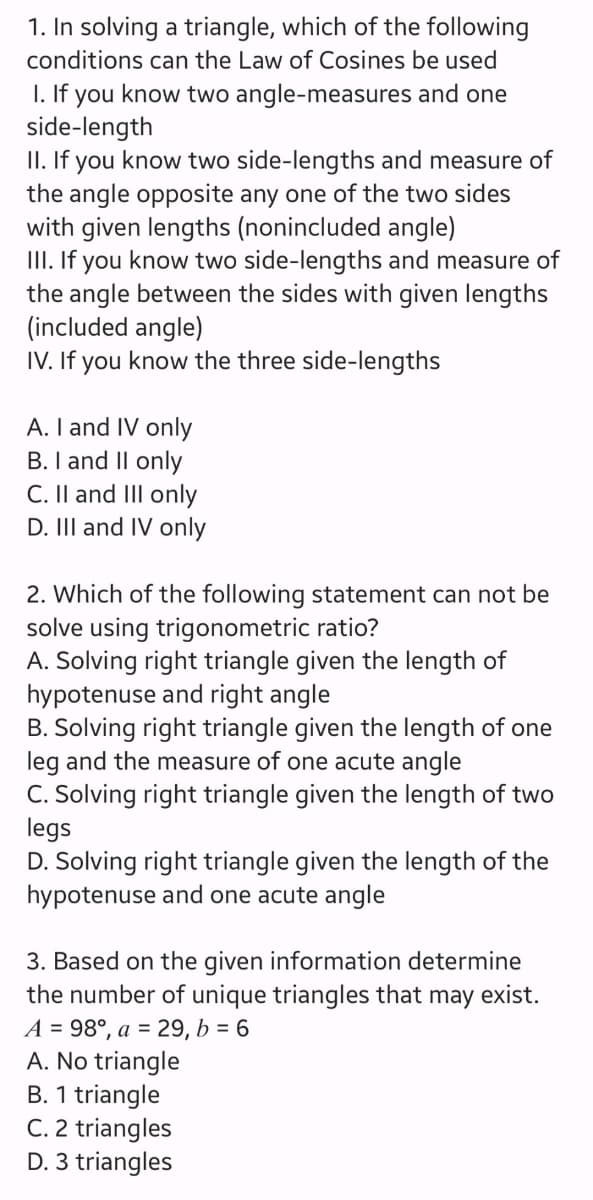1. In solving a triangle, which of the following conditions can the Law of Cosines be used 1. If you know two angle-measures and one side-length II. If you know two side-lengths and measure of the angle opposite any one of the two sides with given lengths (nonincluded angle) III. If you know two side-lengths and measure of the angle between the sides with given lengths (included angle) IV. If you know the three side-lengths A. I and IV only B. I and II only C. II and III only D. III and IV only
1. In solving a triangle, which of the following conditions can the Law of Cosines be used 1. If you know two angle-measures and one side-length II. If you know two side-lengths and measure of the angle opposite any one of the two sides with given lengths (nonincluded angle) III. If you know two side-lengths and measure of the angle between the sides with given lengths (included angle) IV. If you know the three side-lengths A. I and IV only B. I and II only C. II and III only D. III and IV only
Elementary Geometry For College Students, 7e
7th Edition
ISBN:9781337614085
Author:Alexander, Daniel C.; Koeberlein, Geralyn M.
Publisher:Alexander, Daniel C.; Koeberlein, Geralyn M.
Chapter1: Line And Angle Relationships
Section1.4: Relationships: Perpendicular Lines
Problem 30E
Related questions
Question
Answer 1-3 with explanation

Transcribed Image Text:1. In solving a triangle, which of the following
conditions can the Law of Cosines be used
1. If you know two angle-measures and one
side-length
II. If you know two side-lengths and measure of
the angle opposite any one of the two sides
with given lengths (nonincluded angle)
III. If you know two side-lengths and measure of
the angle between the sides with given lengths
(included angle)
IV. If you know the three side-lengths
A. I and IV only
B. I and II onl
C. II and III only
D. III and IV only
2. Which of the following statement can not be
solve using trigonometric ratio?
A. Solving right triangle given the length of
hypotenuse and right angle
B. Solving right triangle given the length of one
leg and the measure of one acute angle
C. Solving right triangle given the length of two
legs
D. Solving right triangle given the length of the
hypotenuse and one acute angle
3. Based on the given information determine
the number of unique triangles that may exist.
A = 98°, a = 29, b = 6
A. No triangle
B. 1 triangle
C. 2 triangles
D. 3 triangles
Expert Solution
This question has been solved!
Explore an expertly crafted, step-by-step solution for a thorough understanding of key concepts.
Step by step
Solved in 2 steps

Recommended textbooks for you

Elementary Geometry For College Students, 7e
Geometry
ISBN:
9781337614085
Author:
Alexander, Daniel C.; Koeberlein, Geralyn M.
Publisher:
Cengage,

Holt Mcdougal Larson Pre-algebra: Student Edition…
Algebra
ISBN:
9780547587776
Author:
HOLT MCDOUGAL
Publisher:
HOLT MCDOUGAL

Mathematics For Machine Technology
Advanced Math
ISBN:
9781337798310
Author:
Peterson, John.
Publisher:
Cengage Learning,

Elementary Geometry For College Students, 7e
Geometry
ISBN:
9781337614085
Author:
Alexander, Daniel C.; Koeberlein, Geralyn M.
Publisher:
Cengage,

Holt Mcdougal Larson Pre-algebra: Student Edition…
Algebra
ISBN:
9780547587776
Author:
HOLT MCDOUGAL
Publisher:
HOLT MCDOUGAL

Mathematics For Machine Technology
Advanced Math
ISBN:
9781337798310
Author:
Peterson, John.
Publisher:
Cengage Learning,

Elementary Geometry for College Students
Geometry
ISBN:
9781285195698
Author:
Daniel C. Alexander, Geralyn M. Koeberlein
Publisher:
Cengage Learning